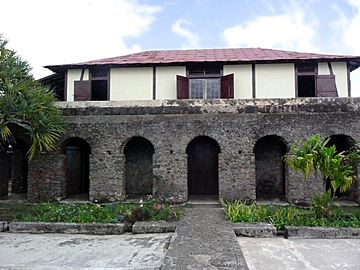Archaeological Landscape of the First Coffee Plantations in the South-East of Cuba facts for kids
| UNESCO World Heritage Site | |
|---|---|

|
|
| Location | Santiago de Cuba Province and Guantánamo Province, Cuba |
| Criteria | Cultural: (iii), (iv) |
| Inscription | 2000 (24th Session) |
| Area | 81,475 ha (314.58 sq mi) |
The Archaeological Landscape of the First Coffee Plantations in the South-East of Cuba is a special place that shows us how coffee was grown a long time ago. It includes the remains of many coffee farms from the 1800s. These farms are located in the mountains of the Sierra Maestra in Cuba.
In the 1800s and early 1900s, eastern Cuba was a big center for growing coffee. The old farms still show us the clever ways people grew coffee on difficult mountain land. They also tell us a lot about the economy and society of that time in Cuba and the Caribbean.
In 2000, this important area was added to the World Heritage Site list by UNESCO. This means it's a place of special importance to everyone in the world.
What are these Coffee Plantations?
This World Heritage site has 171 old coffee farms, called 'cafetales', from the 1800s and early 1900s. They are spread across seven different areas in southeast Cuba.
| ID | Name | Coordinates |
|---|---|---|
| 1008-001 | La Gran Piedra | 20°00′42″N 75°37′51″W / 20.01167°N 75.63083°W |
| 1008-002 | El Cobre | 20°03′09″N 75°56′36″W / 20.05250°N 75.94333°W |
| 1008-003 | Dos Palmas Contramaestre | 20°02′59″N 76°05′01″W / 20.04972°N 76.08361°W |
| 1008-004 | Yateras | 20°21′35″N 74°58′49″W / 20.35972°N 74.98028°W |
| 1008-005 | El Salvador | 20°17′58″N 75°16′24″W / 20.29944°N 75.27333°W |
| 1008-006 | Niceto Pérez | 20°08′31″N 75°19′36″W / 20.14194°N 75.32667°W |
| 1008-007 | Guantanamo | 20°12′43″N 75°12′00″W / 20.21194°N 75.20000°W |
Some of these farms are very well preserved, like Cafetal Isabelica, which has been fully restored. Others are mostly ruins. However, they all had a similar design. In the middle of each farm was the owner's house. These houses often looked like traditional Basque homes from Spain, but they were changed to fit the warm Cuban climate.
Around the owner's house were the homes for the workers. These were usually simple buildings made of wood with roofs of branches and leaves. Each farm also had a special flat area called a 'secadero'. This was used for drying the coffee beans. There were also other buildings for grinding and roasting the coffee.
History of Coffee in Cuba
French settlers started growing coffee in the 1700s on the island of Hispaniola. But in 1804, Haiti (part of Hispaniola) became independent. This caused many French settlers to move to Cuba, which was then ruled by Spain.
During the 1800s, many new coffee farms were started across the Sierra Maestra mountains. However, by the early 1900s, these Cuban farms found it hard to compete with the huge coffee farms in countries like Brazil, Colombia, and Costa Rica. Because of this, the Cuban coffee farms slowly became less important. Today, only a few of these old coffee farms are still working.
Images for kids
See also
 In Spanish: Paisaje arqueológico de las primeras plantaciones de café de Cuba para niños
In Spanish: Paisaje arqueológico de las primeras plantaciones de café de Cuba para niños





